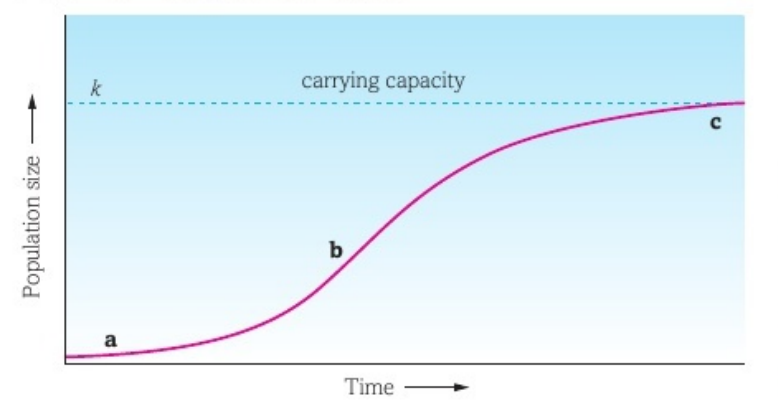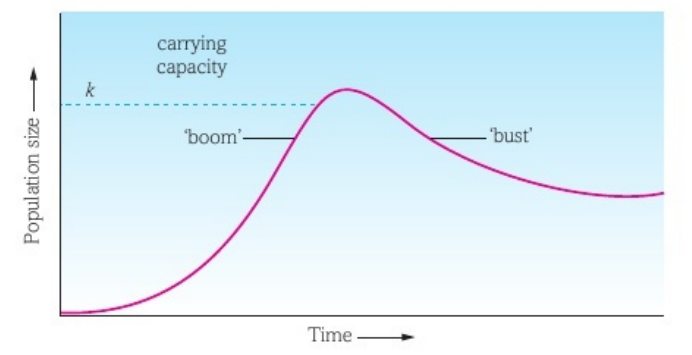Populations and Sustainability
1/16
There's no tags or description
Looks like no tags are added yet.
Name | Mastery | Learn | Test | Matching | Spaced |
|---|
No study sessions yet.
17 Terms
Draw a graph to show population growth of a species and describe each phase
A. Lag phase - only a few individuals, acclimatising to habitat, rate of reproduction, and thus growth, is low
B. Log phase - resources are plentiful, good conditions, reproduction happens quickly and it exceeds mortality rate, rapid population rise
C. Stationary phase - carrying capacity of habitat reached - habitat can’t support a larger population, rates of reproduction and mortality equal, population size stable or slight fluctuation with the seasons

What are limiting factors? Give some examples
F
What are the two types of strategists?
k-Strategists: population determined by carrying capacity of habitat, and limiting factors affect growth, e.g. mammals
low reproductive rate
slow development
late reproductive age
long lifespan
large body mass
r-Strategist: population so fast carrying capacity exceeded before limiting factors have an effect, once succeeded, lack of resources means a stop to reproduction and even death, e.g. insects
high reproductive rate
quick development
young reproductive age
short lifespan
small body mass
Draw a graph to show population growth in r-strategist species
Much like the modern economic cycle of the West…

Draw and describe the population between predators and prey
What are examples of general conservation strategies?
Protected areas like National Parks
Legal protection to endangered species
Conservation ex situ in zoos or botanic gardens
What are specific management strategies?
Raise carrying capacity by providing extra food
Restrict dispersal of individuals using fences
Vaccination against disease
Control predators and poachers
Preserve habitats by preventing pollution or disruption
More individuals to enlarge populations
Encourage natural dispersion of individuals between fragmented habitats using dispersal corridors
Why should habitats conserved?
Ethical responsibility
Provide a value food sources
May be beneficial to medicine
Predators/pests can act as natural control agents
Insects pollinate crops
Ecotourism and recreation
How can small-scale timber production be managed?
Coppicing: stem of a deciduous tree is cut close to the ground, new shoots grow and narrow into mature stems, after cutting them off, new shoots grow, and so on
Pollarding: cutting the stem higher up to prevent deer eating them
Rotational coppicing: wood divided into section and only one section cut each year, good for biodiversity as stops succession where growth of trees blocks light, reducing species below
How can large-scale timber production be managed?
Harvested trees replaced with new ones
Selective cutting: only largest, most valuable trees removed
Only plant particular species where they will grown well
Control of pests
Position trees at optimal position apart, reducing competition
How are fish stocks managed?
Fishing quotas - avoids overfishing
Bigger holes in nets - immature fish can escape, grow and reproduce
Restrict time of year when fishing can happen - protect breeding season
Fish farming - maintains supply and protects wild species (fisheries or aquaculture which involves cultivation of fish under controlled conditions)
Examples of successful conservation
Terai Region, Nepal:
Forests in the region have struggled with agriculture expansion, modern crop-varieties, farm animal grazing and over-exploitation
WWF and Nepalese govt have started a scheme to balance conservation and the stakes of the local community
Community forest initiatives where locals can exploit the forest but must also look after it
Forest corridors between parks, allowing dispersal of animals like tigers
Crackdown on poaching and illegal felling
Waterholes constructed
Endangered species monitored
Invasive species eradicated
Maasai Mara, Kenya:
2005: conservancies formed to generate tourist income, payment for wildlife conservation schemes, tourism operators pay conservancies an income proportional to conserved land, positive social and conservational outcomes
Give four examples of environmentally sensitive ecosystems affected by human activity
Galapagos Islands: many native species, but increased demand for marine products and tourism has caused habitat disturbances and introduction of species (e.g. cats) has led to local species being outcompeted, Charles Darwin Research Station set up a marine reserve, areas undisturbed, introduced species culled
Antarctic: protected areas, fishing evenly distributed to prevent overfishing of krill, albatrosses and petrels threatened by long line fishing, done at night/weighted lines reduce risk
Lake District: conservation workers remove invasive species, more varied planting and felling patterns, limestone pavements legally protected, seasonal restrictions along cliffs on walking when birds are nesting, farmers paid to maintain hay meadows
Snowdonia National Park: drainage ditches caused by farming blocked by hay bales, conifers planted as cash crops dry out moorland so branches laid to block drainage ditches, slowing water flow and keeping land moist